|
جواب |
رسائل 1 من 30 في الفقرة |
|
|
|
|
|
جواب |
رسائل 16 من 30 في الفقرة |
|
El centurión Longino entre las cruces de Cristo y los dos ladrones, 1539
|
|
|
|
|
|
|
|
جواب |
رسائل 17 من 30 في الفقرة |
|

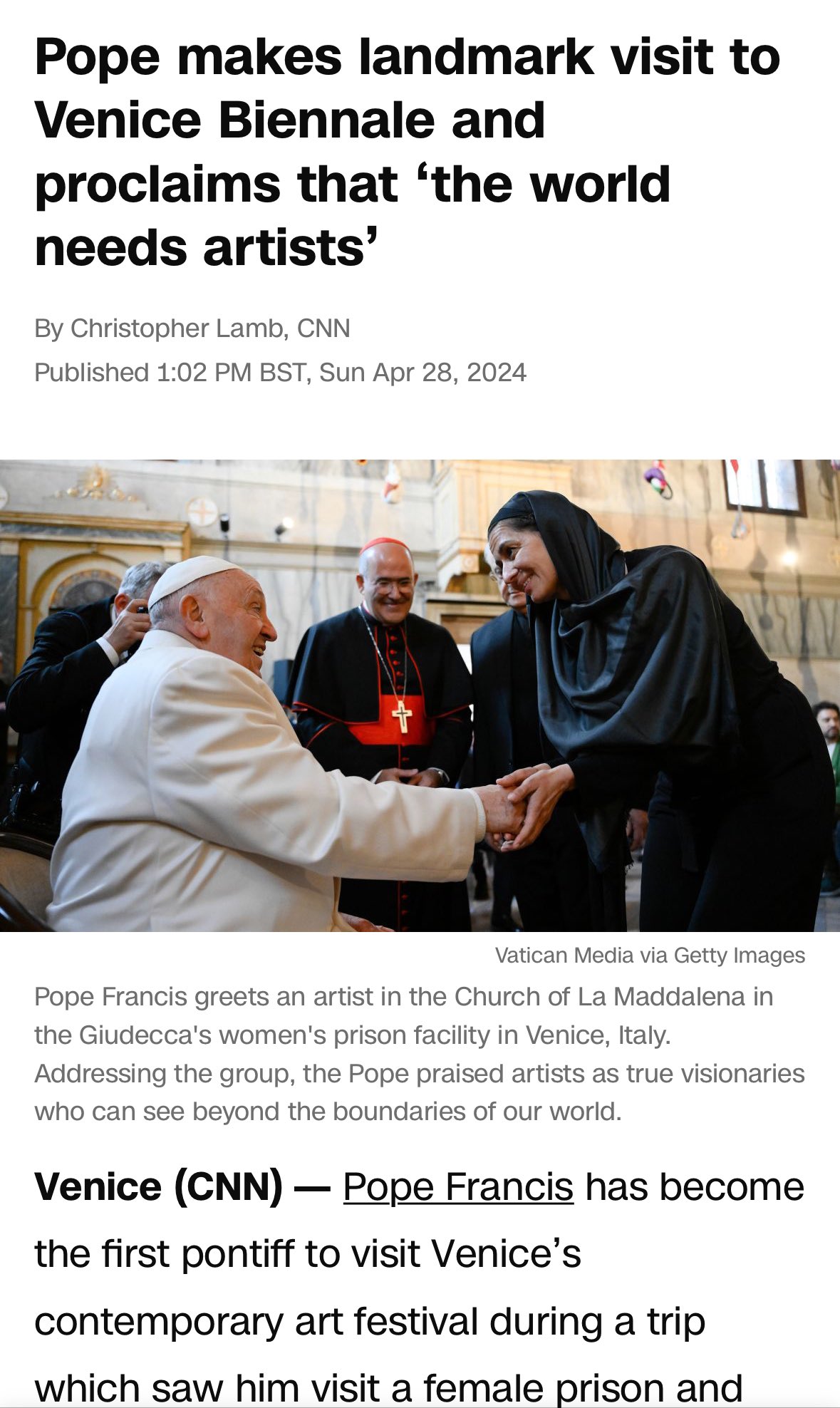
 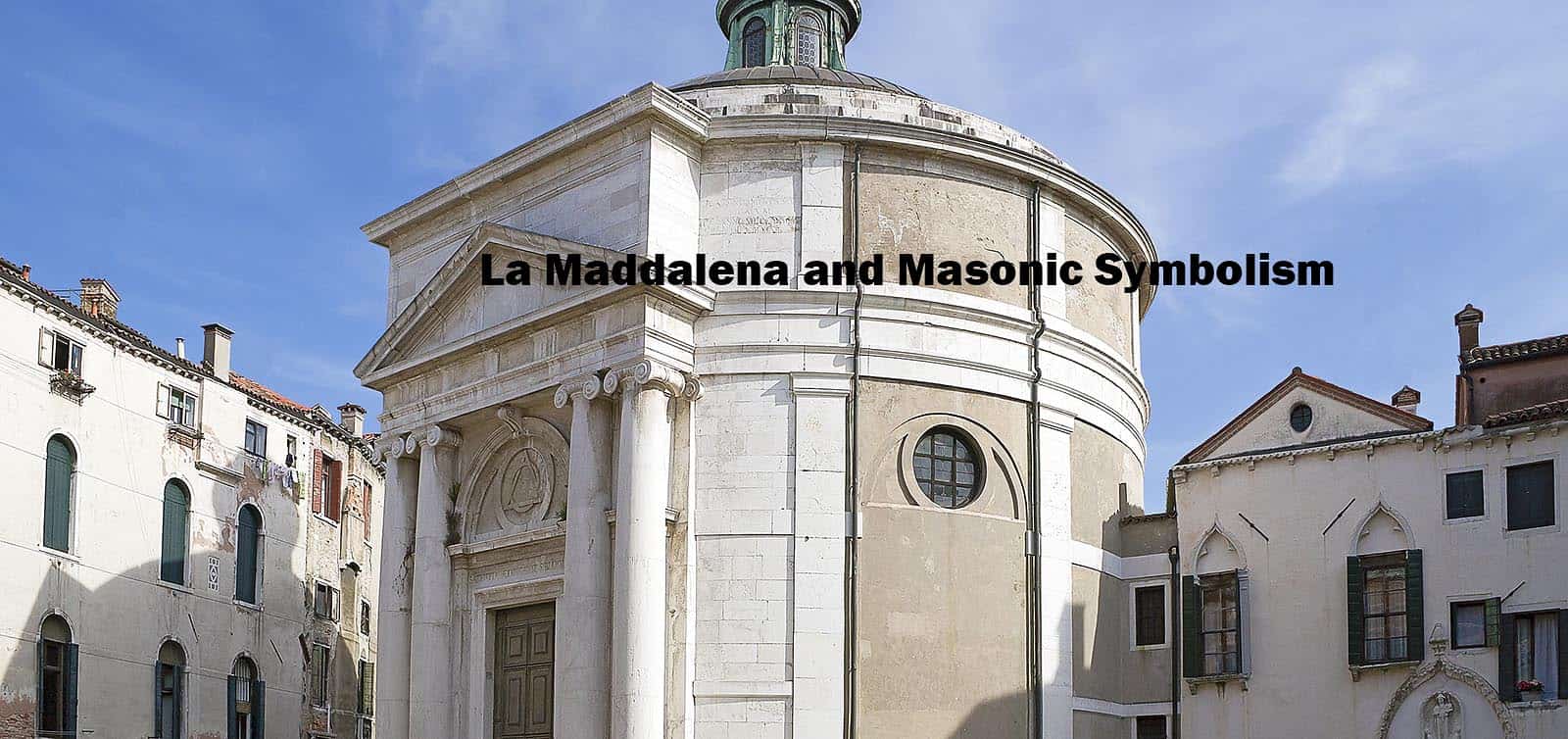      

New International VersionIt is as if the dew of Hermon were falling on Mount Zion. For there the LORD bestows his blessing, even life forevermore.
New Living TranslationHarmony is as refreshing as the dew from Mount Hermon that falls on the mountains of Zion. And there the LORD has pronounced his blessing, even life everlasting.
English Standard VersionIt is like the dew of Hermon, which falls on the mountains of Zion! For there the LORD has commanded the blessing, life forevermore.
Berean Standard BibleIt is like the dew of Hermon falling on the mountains of Zion. For there the LORD has bestowed the blessing of life forevermore.
King James BibleAs the dew of Hermon, and as the dew that descended upon the mountains of Zion: for there the LORD commanded the blessing, even life for evermore.
New King James VersionIt is like the dew of Hermon, Descending upon the mountains of Zion; For there the LORD commanded the blessing— Life forevermore.
New American Standard BibleIt is like the dew of Hermon Coming down upon the mountains of Zion; For the LORD commanded the blessing there—life forever.
NASB 1995It is like the dew of Hermon Coming down upon the mountains of Zion; For there the LORD commanded the blessing— life forever.
NASB 1977It is like the dew of Hermon, Coming down upon the mountains of Zion; For there the LORD commanded the blessing—life forever.
Legacy Standard BibleIt is like the dew of Hermon Coming down upon the mountains of Zion; For there, Yahweh commanded the blessing—life forever.
Amplified BibleIt is like the dew of [Mount] Hermon Coming down on the hills of Zion; For there the LORD has commanded the blessing: life forevermore.
Christian Standard BibleIt is like the dew of Hermon falling on the mountains of Zion. For there the LORD has appointed the blessing — life forevermore.
Holman Christian Standard BibleIt is like the dew of Hermon falling on the mountains of Zion. For there the LORD has appointed the blessing— life forevermore.
American Standard VersionLike the dew of Hermon, That cometh down upon the mountains of Zion: For there Jehovah commanded the blessing, Even life for evermore.
Contemporary English VersionIt is like the dew from Mount Hermon, falling on Zion's mountains, where the LORD has promised to bless his people with life forevermore.
English Revised VersionLike the dew of Hermon, that cometh down upon the mountains of Zion: for there the LORD commanded the blessing, even life for evermore.
GOD'S WORD® TranslationIt is like dew on [Mount] Hermon, dew which comes down on Zion's mountains. That is where the LORD promised the blessing of eternal life.
Good News TranslationIt is like the dew on Mount Hermon, falling on the hills of Zion. That is where the LORD has promised his blessing--life that never ends.
International Standard VersionIt is like the dew of Hermon falling on Zion's mountains. For there the LORD commanded his blessing— life everlasting.
Majority Standard BibleIt is like the dew of Hermon falling on the mountains of Zion. For there the LORD has bestowed the blessing of life forevermore.
NET BibleIt is like the dew of Hermon, which flows down upon the hills of Zion. Indeed that is where the LORD has decreed a blessing will be available--eternal life.
New Heart English Biblelike the dew of Hermon, that comes down on the hills of Zion: for there the LORD gives the blessing, even life forevermore.
Webster's Bible TranslationAs the dew of Hermon, and as the dew that descended upon the mountains of Zion: for there the LORD commanded the blessing, even life for ever.
World English Biblelike the dew of Hermon, that comes down on the hills of Zion; for there Yahweh gives the blessing, even life forever more.
Literal Translations
Literal Standard VersionAs dew of Hermon—That comes down on hills of Zion, "" For there YHWH commanded the blessing—Life for all time!
Young's Literal TranslationAs dew of Hermon -- That cometh down on hills of Zion, For there Jehovah commanded the blessing -- Life unto the age!
Smith's Literal TranslationAs the dew of Hermon coming down upon the mountains of Zion: for there Jehovah commanded the blessing, life even forever.
Catholic Translations
Douay-Rheims Bibleas the dew of Hermon, which descendeth upon mount Sion. For there the Lord hath commandeth blessing, and life for evermore.
Catholic Public Domain VersionIt is like the dew of Hermon, which descended from mount Zion. For in that place, the Lord has commanded a blessing, and life, even unto eternity.
New American BibleLike dew of Hermon coming down upon the mountains of Zion. There the LORD has decreed a blessing, life for evermore!
New Revised Standard VersionIt is like the dew of Hermon, which falls on the mountains of Zion. For there the LORD ordained his blessing, life forevermore.
Translations from Aramaic
Lamsa BibleLike the dew of Hermon that falls upon the mount of Zion; for there the LORD commanded the blessing, even life for evermore.
Peshitta Holy Bible TranslatedLike the dew of Hermon that descends upon the mountain of Zion, because there LORD JEHOVAH commanded the blessing and the Life unto eternity.
OT Translations
JPS Tanakh 1917Like the dew of Hermon, That cometh down upon the mountains of Zion; For there the LORD commanded the blessing, Even life for ever.
Brenton Septuagint TranslationAs the dew of Aermon, that comes down on the mountains of Sion: for there, the Lord commanded the blessing, even life for ever.
Additional Translations ...
|
 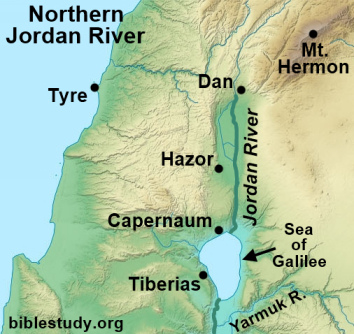  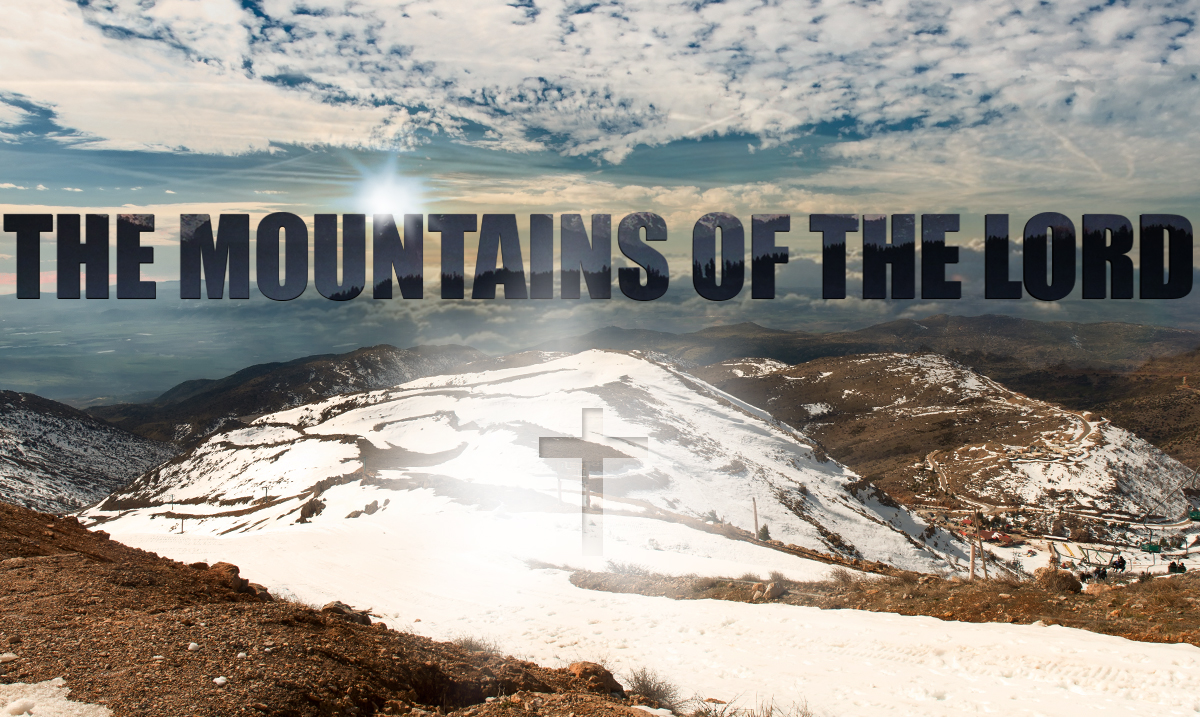  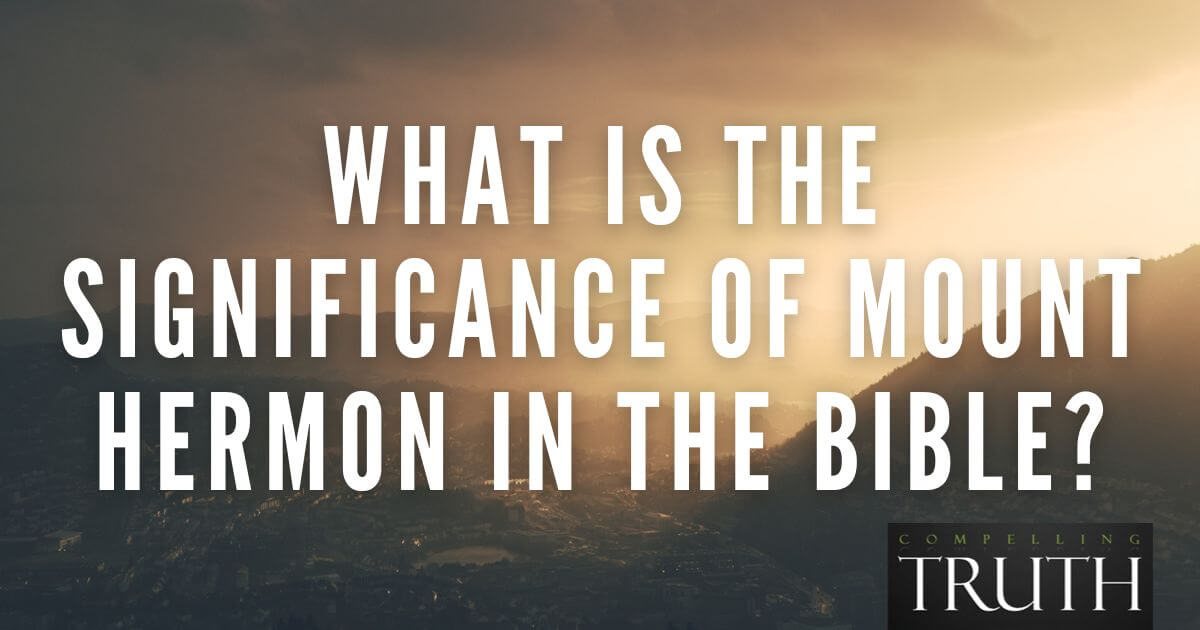 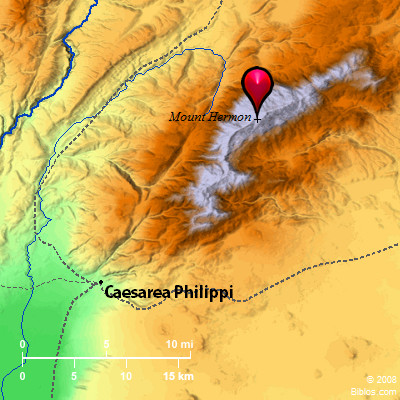 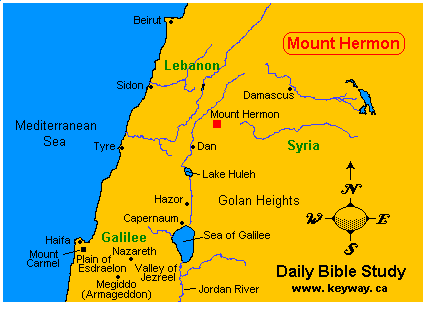     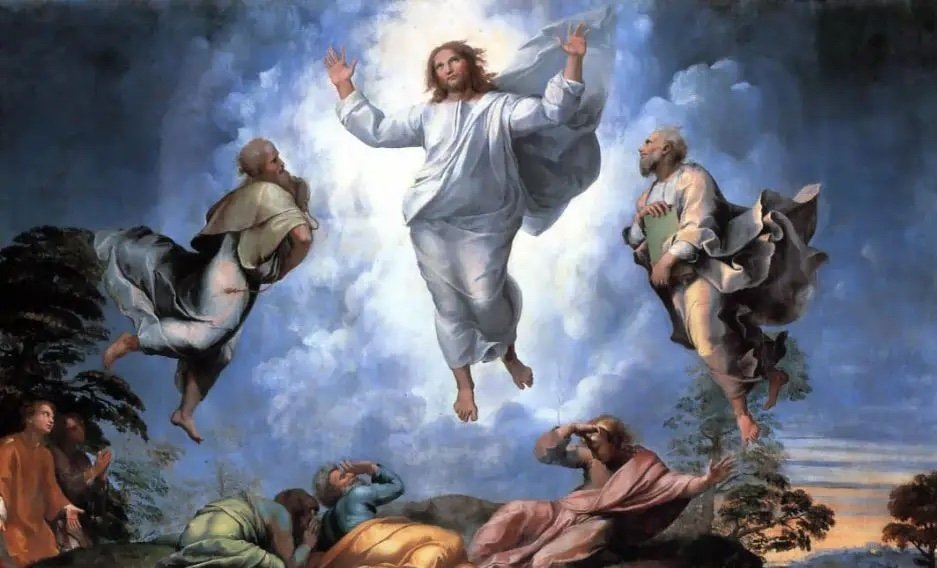   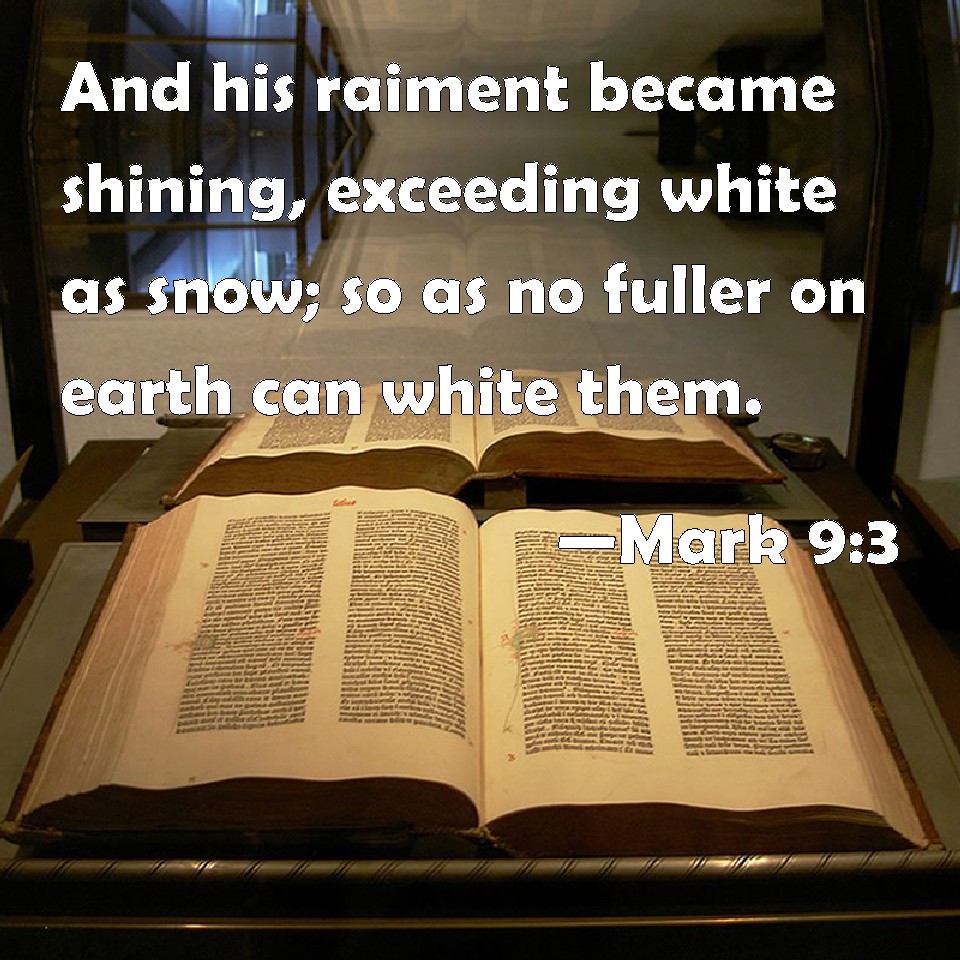 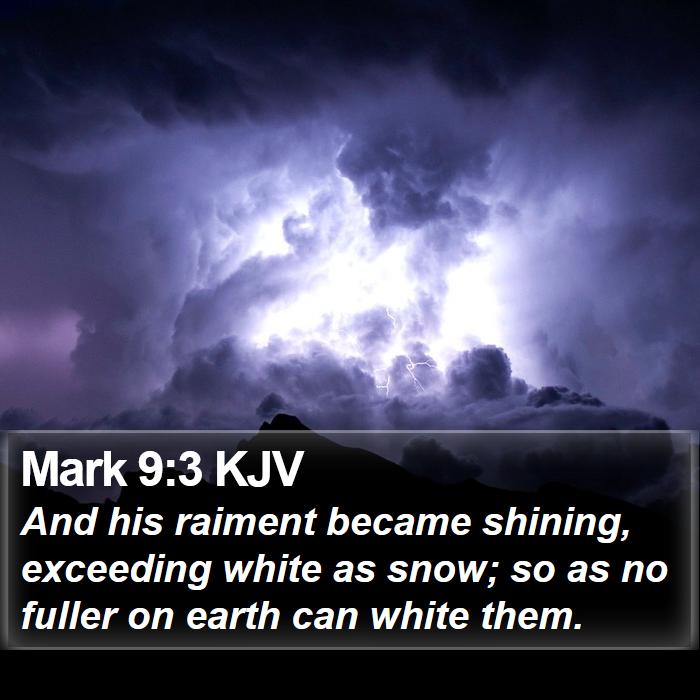
|
|
|
|
جواب |
رسائل 18 من 30 في الفقرة |
|
XXIV ANIVERSARIO DE XOCHITÉCATL.
A finales del mes de noviembre y principios de diciembre, se cumple el XXIV aniversario del Descubrimiento del Centro Ceremonial Xochitécatl, en la zona arqueológica de Cacaxtla, por lo cual, este 2 de diciembre del 2018, se tienen preparados una serie de actividades donde se busca dar a conocer los últimos hallazgos de este sitio, por investigadores y arqueólogos del Instituto Nacional de antropología e Historia (INAH).
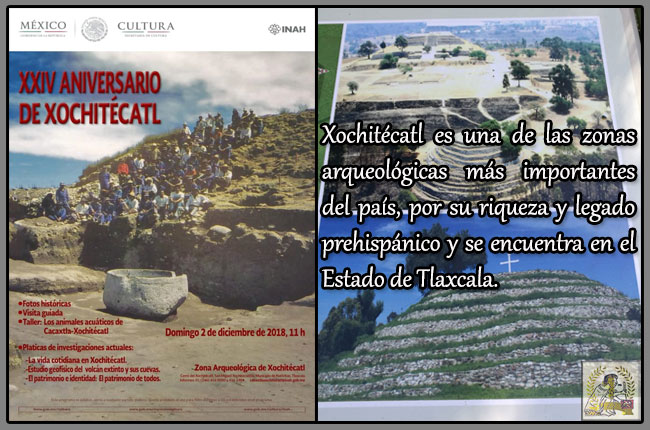 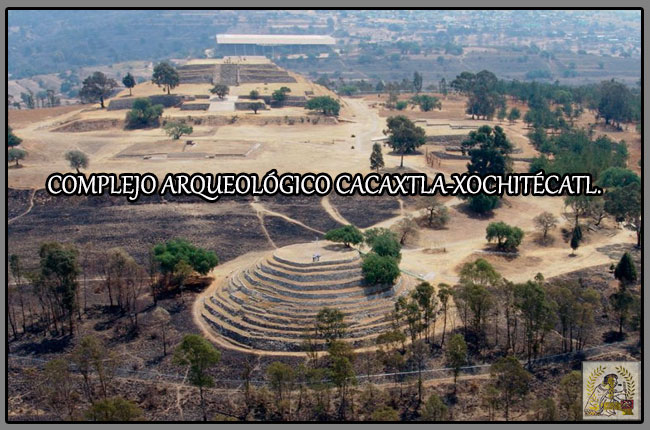 La investigación en el sitio se remonta a los años 40 del siglo pasado, cuando el arqueólogo Pedro Armillas realizó el registro del yacimiento Cacaxtla y Xochitécatl; posteriormente, en los años 60, la Fundación Alemana para la Investigación Científica hizo un proyecto de antropología, arqueología y lingüística, y llevó a cabo un recorrido de superficie, con el que se le dio la fecha de ocupación, ubicándolo en el Formativo Temprano (1000 a.C.). Ese dato se mantuvo hasta los años 90, cuando la doctora Mari Carmen Serra Puche efectuó una excavación extensiva y proporcionó nuevas fechas de ocupación del sitio, cuya construcción inició en 700 a.C. La investigación en el sitio se remonta a los años 40 del siglo pasado, cuando el arqueólogo Pedro Armillas realizó el registro del yacimiento Cacaxtla y Xochitécatl; posteriormente, en los años 60, la Fundación Alemana para la Investigación Científica hizo un proyecto de antropología, arqueología y lingüística, y llevó a cabo un recorrido de superficie, con el que se le dio la fecha de ocupación, ubicándolo en el Formativo Temprano (1000 a.C.). Ese dato se mantuvo hasta los años 90, cuando la doctora Mari Carmen Serra Puche efectuó una excavación extensiva y proporcionó nuevas fechas de ocupación del sitio, cuya construcción inició en 700 a.C.
CACAXTLA.
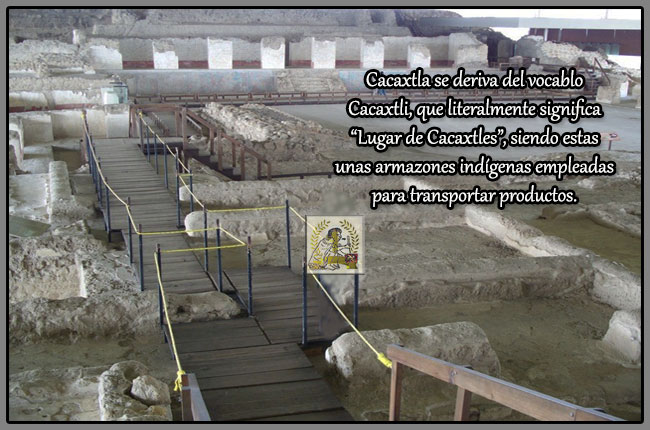 Las investigaciones arqueológicas realizadas en la sección oriente del sitio a partir de su descubrimiento en la década de 1970 en el área conocida como Cacaxtla, develan una de las sociedades más importantes que se desarrollaron en el periodo Epiclásico (650-900 d.C.) de Mesoamérica. Su poderío logró la hegemonía política, militar y económica en gran parte del valle poblano-tlaxcalteca después de la caída de Teotihuacán y Cholula, consiguiendo entablar relaciones comerciales a larga distancia con regiones distantes como la Costa del Golfo y la Cuenca de México. Las investigaciones arqueológicas realizadas en la sección oriente del sitio a partir de su descubrimiento en la década de 1970 en el área conocida como Cacaxtla, develan una de las sociedades más importantes que se desarrollaron en el periodo Epiclásico (650-900 d.C.) de Mesoamérica. Su poderío logró la hegemonía política, militar y económica en gran parte del valle poblano-tlaxcalteca después de la caída de Teotihuacán y Cholula, consiguiendo entablar relaciones comerciales a larga distancia con regiones distantes como la Costa del Golfo y la Cuenca de México.
XOCHITÉCATL.
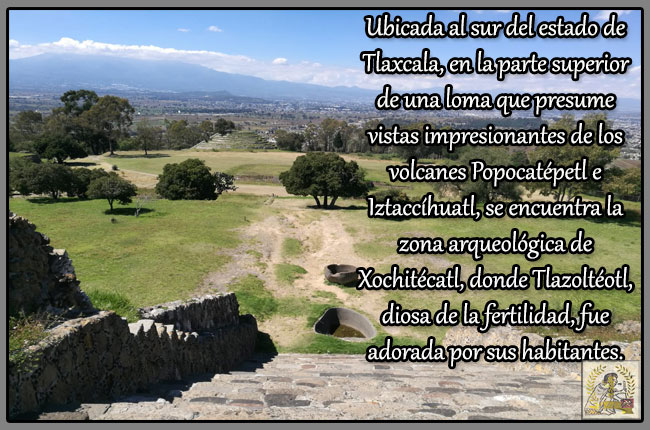 El nombre de Xochitécatl significa en lengua náhuatl “Lugar del linaje de las flores”. La referencia más antigua que se tiene de este lugar se halla representada en el llamado “mapa número dos de Cuauhtinchan”. Documento donde el glifo toponímico de Xochitécatl representado por la imagen de un cerro coronado de flores. El nombre de Xochitécatl significa en lengua náhuatl “Lugar del linaje de las flores”. La referencia más antigua que se tiene de este lugar se halla representada en el llamado “mapa número dos de Cuauhtinchan”. Documento donde el glifo toponímico de Xochitécatl representado por la imagen de un cerro coronado de flores.
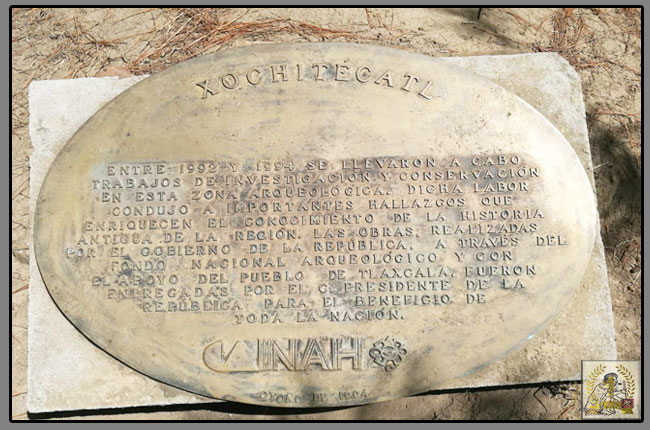 Una de sus principales características fue distinguirse como un centro de labores diversas, a causa de los talleres de navajas identificados y de las tinas, que demostraban un avanzado conocimiento en los procesos de producción. Ahí se realizaban ritos de fertilidad, como lo demuestran los entierros de mujeres e infantes encontrados en la pirámide de las flores, así como la gran cantidad de figurillas femeninas; muchas de ellas se exhiben actualmente en el museo de sitio. Una de sus principales características fue distinguirse como un centro de labores diversas, a causa de los talleres de navajas identificados y de las tinas, que demostraban un avanzado conocimiento en los procesos de producción. Ahí se realizaban ritos de fertilidad, como lo demuestran los entierros de mujeres e infantes encontrados en la pirámide de las flores, así como la gran cantidad de figurillas femeninas; muchas de ellas se exhiben actualmente en el museo de sitio.
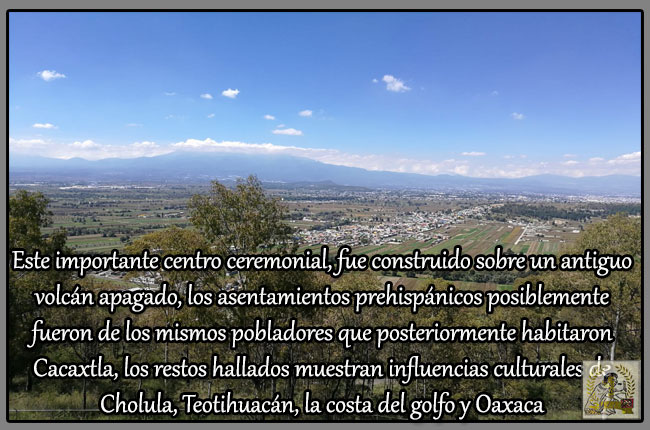 La población que le habitó dedicaba la mayor parte de su tiempo a la agricultura sobre extensas y fértiles planicies que le rodean, y a través de importantes intercambios comerciales obtuvo elementos de lujo para fines ceremoniales, provenientes de varias regiones de Mesoamérica. La población que le habitó dedicaba la mayor parte de su tiempo a la agricultura sobre extensas y fértiles planicies que le rodean, y a través de importantes intercambios comerciales obtuvo elementos de lujo para fines ceremoniales, provenientes de varias regiones de Mesoamérica.
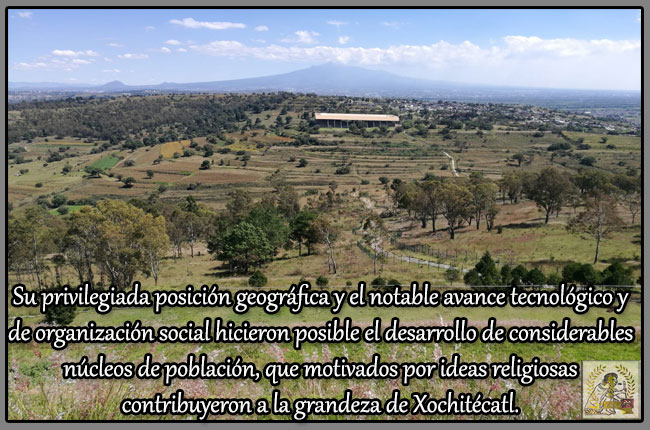
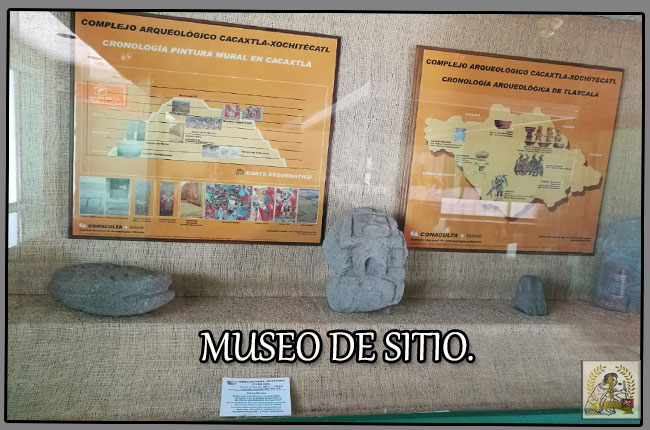 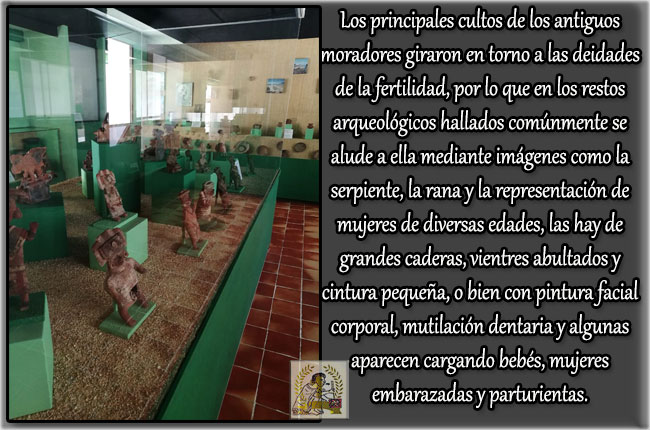  Los entierros son en su mayoría de niños que muestran deformación craneana, cada uno es acompañado de ricas ofrendas mortuorias consistentes en conchas y caracoles marinos, navajillas de obsidiana, cuentas de piedra verde o cuchillos de color gris, anillos y sahumadores. Los entierros son en su mayoría de niños que muestran deformación craneana, cada uno es acompañado de ricas ofrendas mortuorias consistentes en conchas y caracoles marinos, navajillas de obsidiana, cuentas de piedra verde o cuchillos de color gris, anillos y sahumadores.
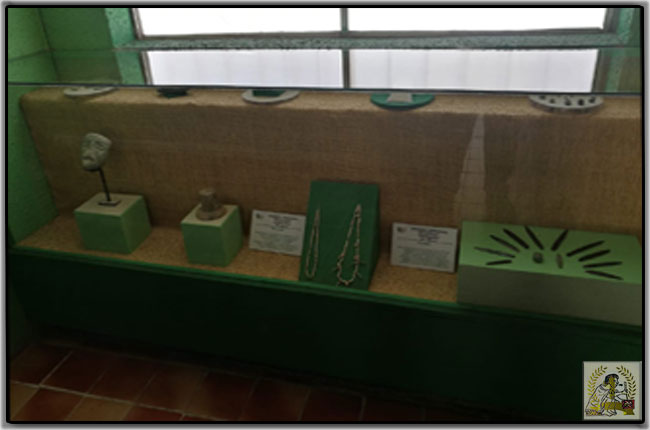 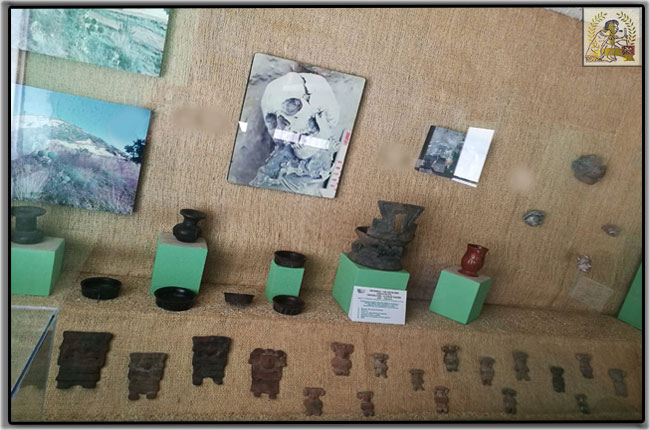 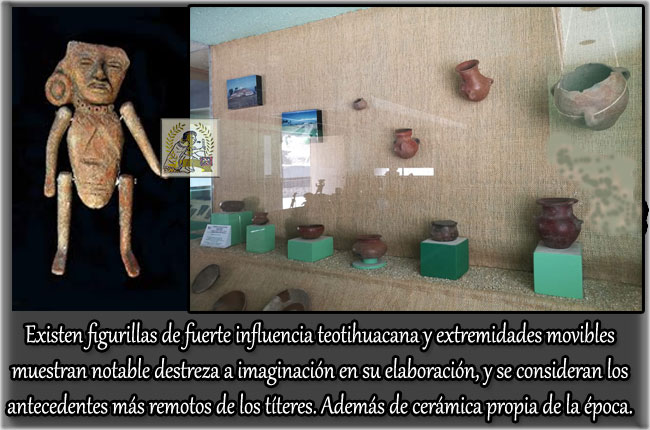
LA GRAN PLAZA Y SUS EDIFICIOS.
Al igual que la gran mayoría de las ciudades prehispánicas, es notoria la presencia de basamentos sobre los cuales se asentaba la morada para los altos sacerdotes y signatarios; así como grandes edificaciones realizadas en forma piramidal en cuya cima se ubican los principales templos o recintos ceremoniales.
LA PIRÁMIDE DE LA ESPIRAL.
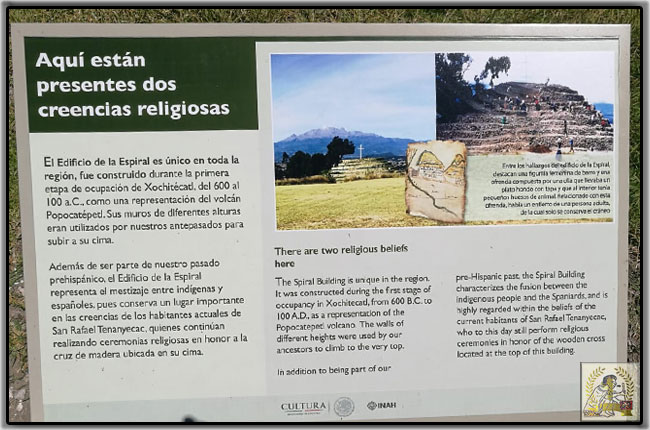 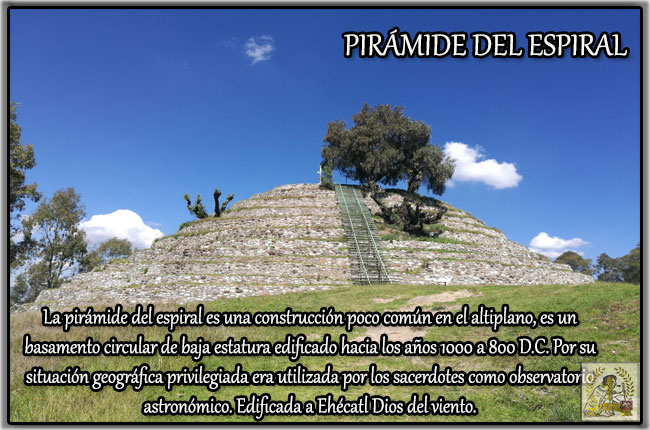 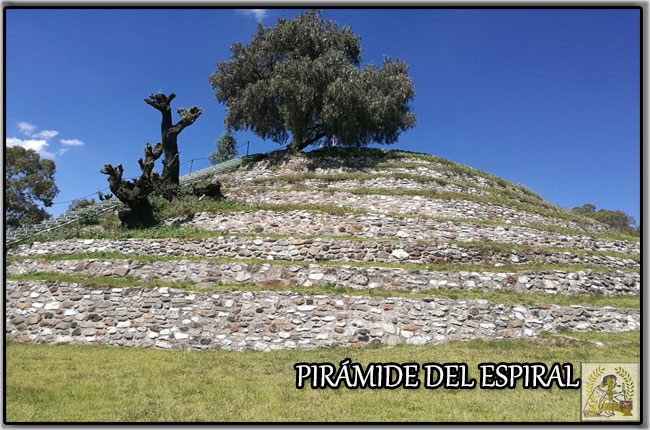 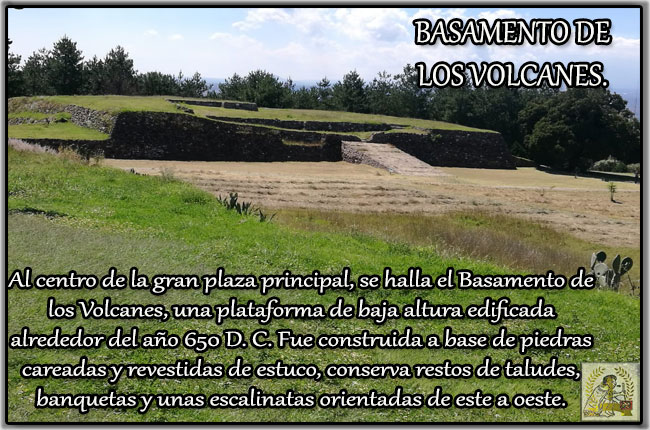 En su parte central y en el interior, se observa una sub-estructura construida en el periodo formativo. En etapas posteriores, aquí mismo fueron depositados varios entierros humanos, uno de ellos relacionados con la clase privilegiada por lo que aparece con ofrendas de placas de piedra verde, figurillas y anillos. En su parte central y en el interior, se observa una sub-estructura construida en el periodo formativo. En etapas posteriores, aquí mismo fueron depositados varios entierros humanos, uno de ellos relacionados con la clase privilegiada por lo que aparece con ofrendas de placas de piedra verde, figurillas y anillos.
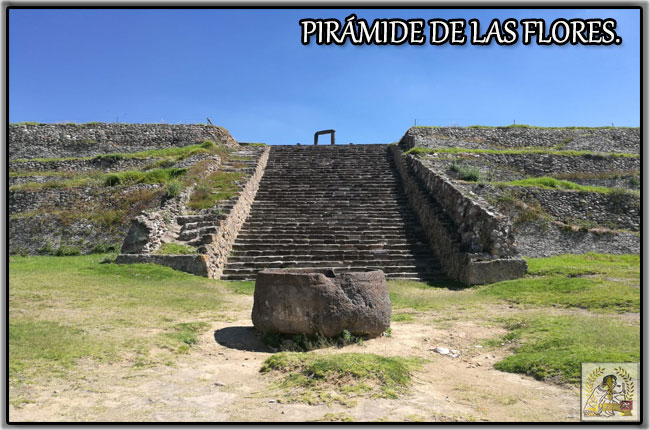 Es la de mayores dimensiones en la zona y a nivel prehispánico es la cuarta más grande de las construcciones mesoamericanas. Es considerada la de mayor importancia en Xochitécatl ya que es la edificación que presenta una secuencia completa de construcción, que va desde el horizonte preclásico o formativo hasta la época colonial. Es la de mayores dimensiones en la zona y a nivel prehispánico es la cuarta más grande de las construcciones mesoamericanas. Es considerada la de mayor importancia en Xochitécatl ya que es la edificación que presenta una secuencia completa de construcción, que va desde el horizonte preclásico o formativo hasta la época colonial.
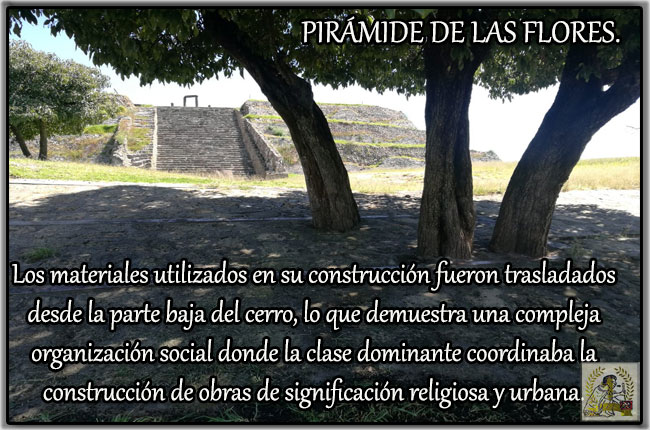 Construida en base a cuerpos rectangulares, su estructura contiene dos terrazas escalonadas y es la que ha aportado la mayor parte de las piezas y elementos arqueológicos, entre los que destacan 30 entierros infantiles y uno de adulto. Construida en base a cuerpos rectangulares, su estructura contiene dos terrazas escalonadas y es la que ha aportado la mayor parte de las piezas y elementos arqueológicos, entre los que destacan 30 entierros infantiles y uno de adulto.
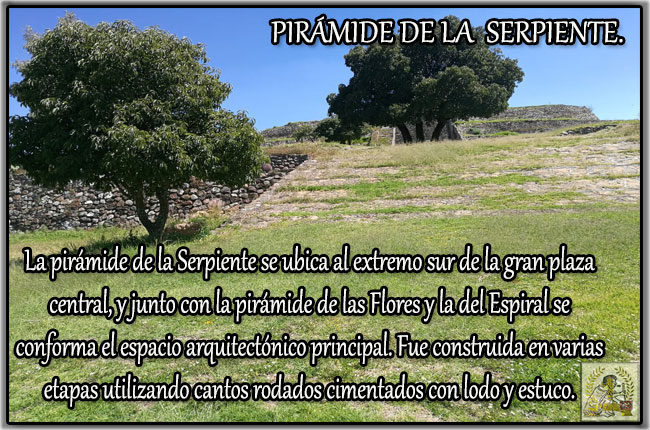 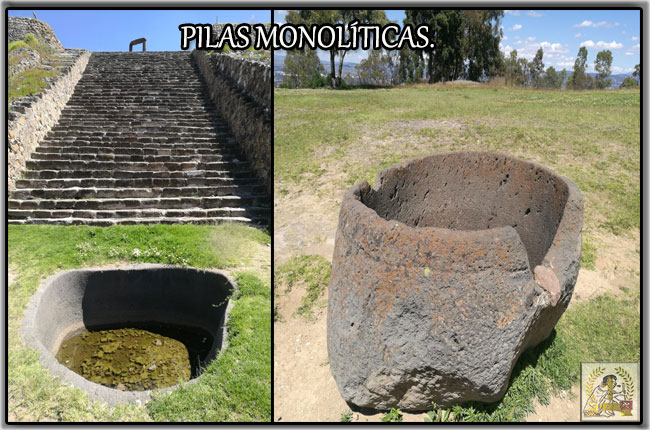 En la parte central de la Pirámide de la Serpiente, se halló una de las tres pilas monolíticas existentes en la zona y cuyo interior conserva una estela mutilada en forma de cabeza de serpiente. Junto a esta se rescató un jaguar y un personaje humano de pie, ojos redondos y boca prominente, que porta una especie de bastón. En la parte central de la Pirámide de la Serpiente, se halló una de las tres pilas monolíticas existentes en la zona y cuyo interior conserva una estela mutilada en forma de cabeza de serpiente. Junto a esta se rescató un jaguar y un personaje humano de pie, ojos redondos y boca prominente, que porta una especie de bastón.
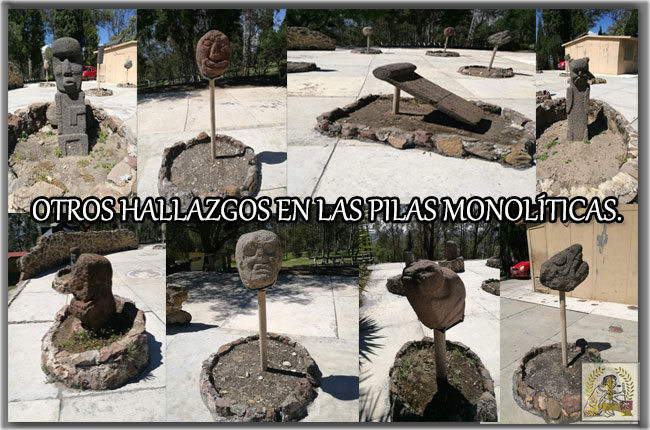 En la terraza superior y frente a las escaleras fueron halladas dos pilas monolíticas cuyo uso fue tal vez astronómico y ritual. Dentro de la pila que se halla por sobre el nivel del piso fueron halladas cuatro esculturas, dos de ellas antropomorfas una zoomorfa y ora mitológica. En la terraza superior y frente a las escaleras fueron halladas dos pilas monolíticas cuyo uso fue tal vez astronómico y ritual. Dentro de la pila que se halla por sobre el nivel del piso fueron halladas cuatro esculturas, dos de ellas antropomorfas una zoomorfa y ora mitológica.
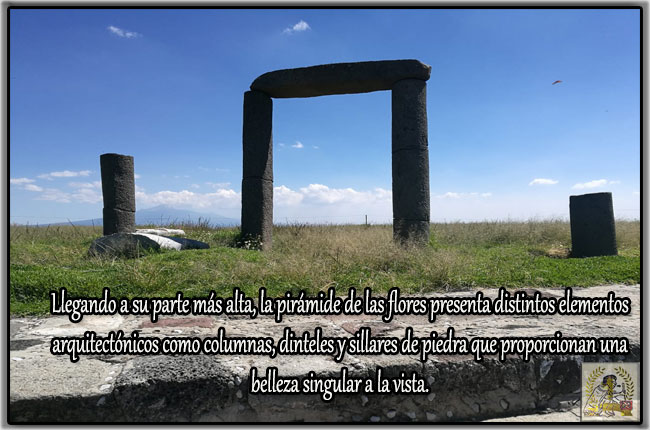 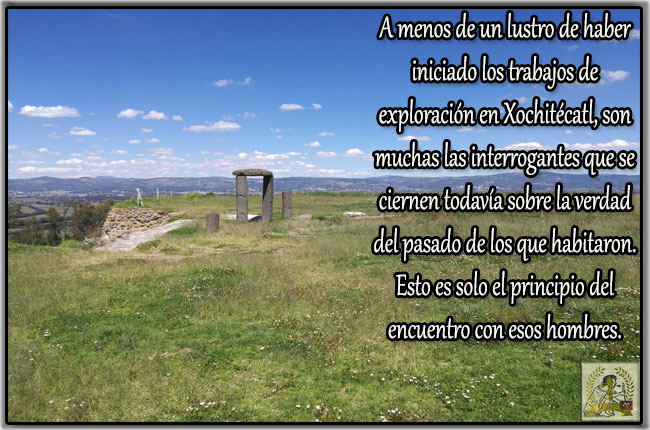 ANDADOR PARA UNIR LOS DOS SITIOS ARQUEOLÓGICOS. ANDADOR PARA UNIR LOS DOS SITIOS ARQUEOLÓGICOS.
En el año 2015, como parte de las actividades realizadas por su XXI aniversario de Xochitécatl, el Gobierno del Estado mandó a construir un andador, con el cual se posibilitaría a los visitantes recorrer los dos espacios en aproximadamente dos horas. El acceso puede ser por cualquiera de los dos sitios y con el pago de un solo boleto. Con este paso peatonal se busca que las comunidades de los alrededores se acerquen más a la zona arqueológica para conocerla y cuidarla, porque es parte de su pasado.
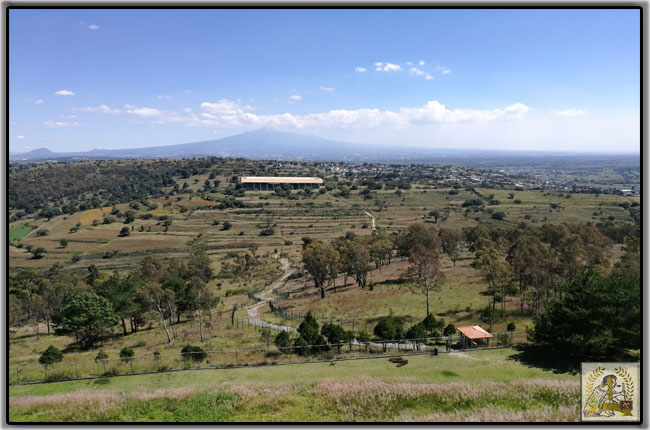 ACCESO. ACCESO.
La zona Arqueológica de Cacaxtla-Xochitécatl se localiza en la población de San Miguel del Milagro, a unos 19 km al suroeste de la capital, en el municipio de Nativitas. Para acceder a las zonas desde el Distrito Federal, se recorre la Autopista No. 150 hasta la caseta de San Martín Texmelucan, Puebla. Unos pocos kilómetros después, se toma la salida del libramiento en Xalmimilulco con dirección al poblado de San Miguel Xochitecatitla, donde se puede seguir las indicaciones para llegar al camino asfaltado (1.9 km.) que sube por la ladera hacia Xochitécatl.
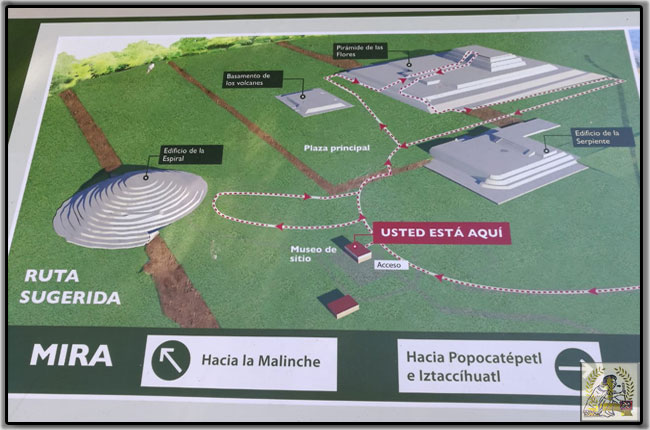 Para visitar Cacaxtla, se debe pasar San Miguel Xochitecatitla continuando en dirección a Nativitas hasta topar con el entronque de San Miguel del Milagro y Cacaxtla. Para visitar Cacaxtla, se debe pasar San Miguel Xochitecatitla continuando en dirección a Nativitas hasta topar con el entronque de San Miguel del Milagro y Cacaxtla.
Los horarios para visitar este complejo arqueológico es: Lunes a Domingo de 09:00 a 17:30 horas. Mayor información en Centro INAH Tlaxcala. tlaxcala.ci@inah.gob.mx
*Revista Cacaxtla, abril, mayo y junio de 1997, número 14, año 1.
*Boletines del INAH.
*Archivo personal Tlaxcala Cultural.
https://tlaxcalacultural.com/2018/11/16/xxiv-aniversario-de-xochitecatl/ |
|
|
|
جواب |
رسائل 19 من 30 في الفقرة |
|
|
|
|
جواب |
رسائل 20 من 30 في الفقرة |
|
|
FATIMA=SEPTEMBER 11TH (MARS)
|
|
|
|
|
FATIMA=SEPTEMBER 11TH (MARS)/TUESDAY
MAY 1TH 1917 (FATIMA) MARS/TUESDAY
DECEMBER 25TH 1917 (FATIMA) MARS/TUESDAY
JANUARY 1TH 1918 MARS/TUESDAY
|
|
|
|
|
|
|
جواب |
رسائل 21 من 30 في الفقرة |
|
|
|
|
جواب |
رسائل 22 من 30 في الفقرة |
|
|
|
|
جواب |
رسائل 23 من 30 في الفقرة |
|
|
|
|
جواب |
رسائل 24 من 30 في الفقرة |
|
French President Emmanuel Macron, center, poses with President-elect Donald Trump, left, and Ukraine’s President Volodymyr Zelenskyy at the Elysee Palace, Saturday, Dec. 7, 2024 in Paris. (AP Photo/Aurelien Morissard)
https://www.wdtn.com/news/politics/ap-politics/ap-trump-is-traveling-to-paris-for-notre-dame-cathedrals-reopening-celebration-will-meet-with-macron/
|
|
|
|
جواب |
رسائل 25 من 30 في الفقرة |
|
|
|
|
جواب |
رسائل 26 من 30 في الفقرة |
|
|
|
|
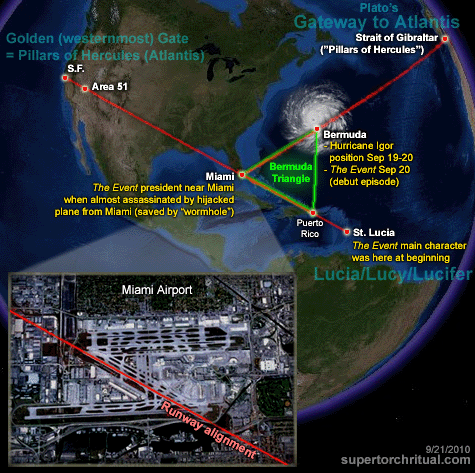
'Pillars of Hercules':
Quintessential geographical marker for Atlantis
per Plato's writings (said Atlantis lay beyond this gate)
https://www.goroadachi.com/etemenanki/updates-oct10.htm |
|
|
|
|
|
|
جواب |
رسائل 27 من 30 في الفقرة |
|
|
|
|
جواب |
رسائل 28 من 30 في الفقرة |
|
|
|
|
جواب |
رسائل 29 من 30 في الفقرة |
|
It is said that Paris esoterically derives its name from 'Par Isis' ('near Isis'). There is a lot of evidence to support this. As Robert Bauval writes in Secret Chamber (p.341):
 Napoleon had acquired two nicknames, one being 'L'Aigle' (the Eagle) and the other being 'L'Etoile' (the Star). That 'his star' was Sirius, the star of Isis, is not only made obvious by the coat-of-arms which he chose for Paris but, in a more arcane manner, it seems to have been linked to Napoleon's most famous monument, the Arc de Triomphe, also known as the the Place de L'Etoile (the Place of the Star), Napoleon had acquired two nicknames, one being 'L'Aigle' (the Eagle) and the other being 'L'Etoile' (the Star). That 'his star' was Sirius, the star of Isis, is not only made obvious by the coat-of-arms which he chose for Paris but, in a more arcane manner, it seems to have been linked to Napoleon's most famous monument, the Arc de Triomphe, also known as the the Place de L'Etoile (the Place of the Star),  located on the western side of the so-called Historical Axis of Paris, better known as the Champs-Elysees, [which is oriented twenty-six degrees north of west]... The star Sirius, as seen from the latitude of Paris, rises twenty-six degrees south of east. located on the western side of the so-called Historical Axis of Paris, better known as the Champs-Elysees, [which is oriented twenty-six degrees north of west]... The star Sirius, as seen from the latitude of Paris, rises twenty-six degrees south of east.
And sure enough the 'Axis of Paris' (the Champs Elysees) was designed to align with the sunset on ~August 6.
This first of all confirms that the date is to be seen as a special day of Sirius' rising, and makes it clear that August 6 is a 'magical date' that is considered very important by past and modern 'esotericists' whose knowledge stems from ancient Egypt. Judging from the 'rise of Schwarzenegger' masterfully brought about on this date in 2003, we can infer that there is something big underway at this time. The encoded symbolism of the Osirian resurrection - or the birth of Horus - should therefore be treated seriously. Indeed, we just may be talking about something akin to the 'rise of Antichrist' here, if that gets your attention... Think Napoleon; think Hitler.
Napoleon is often thought to have been an 'antichristic' figure especially in the context of Nostradamus' prophecies. We often hear that he was 'Antichrist 1', Hitler was 'Antichrist 2', and the third has yet to come... Well, Terminator 3 was in theaters last year just before Schwarzenegger's rise in politics. So we wonder: Was 'Terminator 3' an allusion to 'Antichrist 3'? The answer we find here is amusing and ominous.
The following passage is from the Book of Revelation, apparently talking about an antichristic figure:
And they had a king over them, which is the angel of the bottomless pit, whose name in the Hebrew tongue is Abaddon, but in the Greek tongue hath his name Apollyon.
The two names given here, 'Abaddon' and 'Apollyon', both mean the same thing - 'Destroyer'... or even 'Terminator'! And Arnold is not only the Hollywood 'Terminator', he's also been Conan the Destroyer (1984)! The name 'Napoleon' has also been interpreted to mean none other than 'destroyer'... The parallel goes even further as we find that just as Napoleon had the nickname 'the Eagle', the name 'Arnold' means 'eagle rules'.
So, yes - the title 'Terminator 3' does scream 'Antichrist 3'... at least on a symbolic level.
What's more ominous, the chapter/verse number of the Revelation passage above from the New Testament happens to be... 9:11. We are about to see just how fitting this 'coincidental' reference is.
https://www.goroadachi.com/etemenanki/lucifer-timecode.htm
|
|
|
|
جواب |
رسائل 30 من 30 في الفقرة |
|
Vézelay, Saint Maximin and the relics of Mary Magdalene

Vezelay and Saint Maximin, an incredible “war” for the relics of Mary Magdalene
Mary Magdalene did not immediately have a great aura in the history of the Church. It was not until the 7th and 8th centuries that she began to be favored in monastic circles, where the accent was placed on repentance and forgiveness by welcoming sinners there. The life of the saint – a sinner who became an ascetic – then merges with the traditions concerning the life of Mary the Egyptian. She was a prostitute of the six century who would have done penance in the desert, on the other side of the Mediterranean.
In the 11th century, the monasteries, under the influence of the order of Cluny, took on social and economic importance. There is also a tremendous cult around all kinds of relics brought back from the Holy Land or purchased in Constantinople. Having relics of great saints is important at this time. It is because there are relics that pilgrimages are organized and pilgrimages pay off. In Vézelay at the beginning of the 11th century the monastery was in full decline. Wishing to promote his abbey, Abbot Geoffroy (1037-1052), friend of the pope, ambitious and close to princes “discovered” (“invented” is the term of use) and exhibited the relics of Mary Magdalene. Pilgrims flock.
 Relic of Mary Magdalene, Vezelay basilica In 1050 Mary Magdalene officially became the patron saint of Vezelay abbey.
Over the 11th and 12th centuries, the abbey, many times enlarged and rebuilt, was transformed into a magnificent sanctuary, with splendid Romanesque portals. It was an important stopover on the way to Compostela. The city took advantage of the influx of pilgrims. In the 12th century, its population amounted to 10,000 inhabitants, a considerable number for the time. Vézelay then became a center of great importance for the West.
Under the protection of the powerful dukes of Burgundy, in 1146, Saint Benedict preached the second crusade there. King Louis VII, Queen Eleanor and a crowd of nobles, prelates and people gathered on the hill.
In 1190, Richard Coeur-de-Lion and Philippe-Auguste met there at the start of the third crusade.
In 1217, François d’Assise chose the hill of Vézelay to found the first Franciscan establishment on French soil.
 Saint Bernard preaching the 2nd Crusade, in Vézelay, in 1146, Émile Signol – Public domain How the relics of Mary Magdalene arrived in Vézelay ?
Natural curiosity, but unsatisfactory answers.
We accepted the idea that it was Gérard de Roussillon who would have organized the transfer of the relics during the foundation of the abbey, relics that we would have gone to look for in Saint-Maximin where we knew that the saint had her burial. .
The bishop of Autun launched a prohibition against the pilgrimage. We then asked for the arbitration of the Pope. Pascal II, who by a bull given in 1103, broke the prohibition of the bishop and invited all the French to make the pilgrimage of Vézelay. The pilgrimage then took off, these were the great hours of Vézelay.
However, doubt persisted, not about the burial of Mary Magdalene in Provence, but about the transfer of her relics to Vézelay and their authenticity. We didn’t have much to show as relics in Vézelay, where we talked about them a lot without ever really presenting them in public.
“Presentable” and “indisputable” relics were needed. It was then that in 1265, relics were exhumed in Vézelay, kept in a box which would have been deposited in the crypt in 920 more than three centuries earlier. A certificate of authenticity in the box proves this!. “…under the high altar, a metal chest, long square, which contained some relics wrapped in two veils of silk, with a certain quantity woman’s hair”. There was also a letter from a King Charles certifying that “in this coffer is contained the body of the blessed Mary Magdalene”. (Act drawn up by Gui de Mello, bishop of Auxerre and Pierre, bishop of Panéade.)
Saint Louis officially recognized the relics and went to Vézelay for their elevation in 1267.
 Vezelay basilica  St Maximin basilica
Nevertheless, the doubt still persisted.
Twelve years later, in 1279, Charles II, Prince of Salerno, nephew of Saint Louis, who had come to Saint-Maximin on pilgrimage and had carried out a solid investigation, was convinced that the tomb of Mary Magdalene was in the crypt. where Saint Maximin had once buried her.
He organized excavations which led to the discovery of several sarcophagi. In the so-called “Sidoine’s sarcophagus” was discovered the body of Mary Magdalene with an inscription on a wooden tablet on which appeared simply: “Here lies the body of Saint Mary Magdalene.”

And finally, for the Abbey of Vézelay, the miracle will not take place.
Indeed, Pope Boniface VIII definitively put an end to this “battle” between the 2 cities when he recognized the authenticity of the relics discovered by Charles II at Saint Maximin.
Vézelay will have to submit to the spiritual authority of the Pope. At the end of the 13th century, it is the beginning of the decline of the pilgrimage of Vézelay.The reliquary in the crypt of Vezelay contains a piece of her rib bone, given by the Dominican monks of St Maximin.
https://www.magdalenesacredjourneys.com/vezelay-saint-maximin-and-the-relics-of-mary-magdalene/ |
|
|
 أول أول
 سابق
16 a 30 de 30
لاحق سابق
16 a 30 de 30
لاحق
 آخر
آخر

|

 La investigación en el sitio se remonta a los años 40 del siglo pasado, cuando el arqueólogo Pedro Armillas realizó el registro del yacimiento Cacaxtla y Xochitécatl; posteriormente, en los años 60, la Fundación Alemana para la Investigación Científica hizo un proyecto de antropología, arqueología y lingüística, y llevó a cabo un recorrido de superficie, con el que se le dio la fecha de ocupación, ubicándolo en el Formativo Temprano (1000 a.C.). Ese dato se mantuvo hasta los años 90, cuando la doctora Mari Carmen Serra Puche efectuó una excavación extensiva y proporcionó nuevas fechas de ocupación del sitio, cuya construcción inició en 700 a.C.
La investigación en el sitio se remonta a los años 40 del siglo pasado, cuando el arqueólogo Pedro Armillas realizó el registro del yacimiento Cacaxtla y Xochitécatl; posteriormente, en los años 60, la Fundación Alemana para la Investigación Científica hizo un proyecto de antropología, arqueología y lingüística, y llevó a cabo un recorrido de superficie, con el que se le dio la fecha de ocupación, ubicándolo en el Formativo Temprano (1000 a.C.). Ese dato se mantuvo hasta los años 90, cuando la doctora Mari Carmen Serra Puche efectuó una excavación extensiva y proporcionó nuevas fechas de ocupación del sitio, cuya construcción inició en 700 a.C. Las investigaciones arqueológicas realizadas en la sección oriente del sitio a partir de su descubrimiento en la década de 1970 en el área conocida como Cacaxtla, develan una de las sociedades más importantes que se desarrollaron en el periodo Epiclásico (650-900 d.C.) de Mesoamérica. Su poderío logró la hegemonía política, militar y económica en gran parte del valle poblano-tlaxcalteca después de la caída de Teotihuacán y Cholula, consiguiendo entablar relaciones comerciales a larga distancia con regiones distantes como la Costa del Golfo y la Cuenca de México.
Las investigaciones arqueológicas realizadas en la sección oriente del sitio a partir de su descubrimiento en la década de 1970 en el área conocida como Cacaxtla, develan una de las sociedades más importantes que se desarrollaron en el periodo Epiclásico (650-900 d.C.) de Mesoamérica. Su poderío logró la hegemonía política, militar y económica en gran parte del valle poblano-tlaxcalteca después de la caída de Teotihuacán y Cholula, consiguiendo entablar relaciones comerciales a larga distancia con regiones distantes como la Costa del Golfo y la Cuenca de México. El nombre de Xochitécatl significa en lengua náhuatl “Lugar del linaje de las flores”. La referencia más antigua que se tiene de este lugar se halla representada en el llamado “mapa número dos de Cuauhtinchan”. Documento donde el glifo toponímico de Xochitécatl representado por la imagen de un cerro coronado de flores.
El nombre de Xochitécatl significa en lengua náhuatl “Lugar del linaje de las flores”. La referencia más antigua que se tiene de este lugar se halla representada en el llamado “mapa número dos de Cuauhtinchan”. Documento donde el glifo toponímico de Xochitécatl representado por la imagen de un cerro coronado de flores. Una de sus principales características fue distinguirse como un centro de labores diversas, a causa de los talleres de navajas identificados y de las tinas, que demostraban un avanzado conocimiento en los procesos de producción. Ahí se realizaban ritos de fertilidad, como lo demuestran los entierros de mujeres e infantes encontrados en la pirámide de las flores, así como la gran cantidad de figurillas femeninas; muchas de ellas se exhiben actualmente en el museo de sitio.
Una de sus principales características fue distinguirse como un centro de labores diversas, a causa de los talleres de navajas identificados y de las tinas, que demostraban un avanzado conocimiento en los procesos de producción. Ahí se realizaban ritos de fertilidad, como lo demuestran los entierros de mujeres e infantes encontrados en la pirámide de las flores, así como la gran cantidad de figurillas femeninas; muchas de ellas se exhiben actualmente en el museo de sitio. La población que le habitó dedicaba la mayor parte de su tiempo a la agricultura sobre extensas y fértiles planicies que le rodean, y a través de importantes intercambios comerciales obtuvo elementos de lujo para fines ceremoniales, provenientes de varias regiones de Mesoamérica.
La población que le habitó dedicaba la mayor parte de su tiempo a la agricultura sobre extensas y fértiles planicies que le rodean, y a través de importantes intercambios comerciales obtuvo elementos de lujo para fines ceremoniales, provenientes de varias regiones de Mesoamérica.

 Los entierros son en su mayoría de niños que muestran deformación craneana, cada uno es acompañado de ricas ofrendas mortuorias consistentes en conchas y caracoles marinos, navajillas de obsidiana, cuentas de piedra verde o cuchillos de color gris, anillos y sahumadores.
Los entierros son en su mayoría de niños que muestran deformación craneana, cada uno es acompañado de ricas ofrendas mortuorias consistentes en conchas y caracoles marinos, navajillas de obsidiana, cuentas de piedra verde o cuchillos de color gris, anillos y sahumadores.


 En su parte central y en el interior, se observa una sub-estructura construida en el periodo formativo. En etapas posteriores, aquí mismo fueron depositados varios entierros humanos, uno de ellos relacionados con la clase privilegiada por lo que aparece con ofrendas de placas de piedra verde, figurillas y anillos.
En su parte central y en el interior, se observa una sub-estructura construida en el periodo formativo. En etapas posteriores, aquí mismo fueron depositados varios entierros humanos, uno de ellos relacionados con la clase privilegiada por lo que aparece con ofrendas de placas de piedra verde, figurillas y anillos. Es la de mayores dimensiones en la zona y a nivel prehispánico es la cuarta más grande de las construcciones mesoamericanas. Es considerada la de mayor importancia en Xochitécatl ya que es la edificación que presenta una secuencia completa de construcción, que va desde el horizonte preclásico o formativo hasta la época colonial.
Es la de mayores dimensiones en la zona y a nivel prehispánico es la cuarta más grande de las construcciones mesoamericanas. Es considerada la de mayor importancia en Xochitécatl ya que es la edificación que presenta una secuencia completa de construcción, que va desde el horizonte preclásico o formativo hasta la época colonial. Construida en base a cuerpos rectangulares, su estructura contiene dos terrazas escalonadas y es la que ha aportado la mayor parte de las piezas y elementos arqueológicos, entre los que destacan 30 entierros infantiles y uno de adulto.
Construida en base a cuerpos rectangulares, su estructura contiene dos terrazas escalonadas y es la que ha aportado la mayor parte de las piezas y elementos arqueológicos, entre los que destacan 30 entierros infantiles y uno de adulto.
 En la parte central de la Pirámide de la Serpiente, se halló una de las tres pilas monolíticas existentes en la zona y cuyo interior conserva una estela mutilada en forma de cabeza de serpiente. Junto a esta se rescató un jaguar y un personaje humano de pie, ojos redondos y boca prominente, que porta una especie de bastón.
En la parte central de la Pirámide de la Serpiente, se halló una de las tres pilas monolíticas existentes en la zona y cuyo interior conserva una estela mutilada en forma de cabeza de serpiente. Junto a esta se rescató un jaguar y un personaje humano de pie, ojos redondos y boca prominente, que porta una especie de bastón. En la terraza superior y frente a las escaleras fueron halladas dos pilas monolíticas cuyo uso fue tal vez astronómico y ritual. Dentro de la pila que se halla por sobre el nivel del piso fueron halladas cuatro esculturas, dos de ellas antropomorfas una zoomorfa y ora mitológica.
En la terraza superior y frente a las escaleras fueron halladas dos pilas monolíticas cuyo uso fue tal vez astronómico y ritual. Dentro de la pila que se halla por sobre el nivel del piso fueron halladas cuatro esculturas, dos de ellas antropomorfas una zoomorfa y ora mitológica.
 ANDADOR PARA UNIR LOS DOS SITIOS ARQUEOLÓGICOS.
ANDADOR PARA UNIR LOS DOS SITIOS ARQUEOLÓGICOS. Para visitar Cacaxtla, se debe pasar San Miguel Xochitecatitla continuando en dirección a Nativitas hasta topar con el entronque de San Miguel del Milagro y Cacaxtla.
Para visitar Cacaxtla, se debe pasar San Miguel Xochitecatitla continuando en dirección a Nativitas hasta topar con el entronque de San Miguel del Milagro y Cacaxtla.

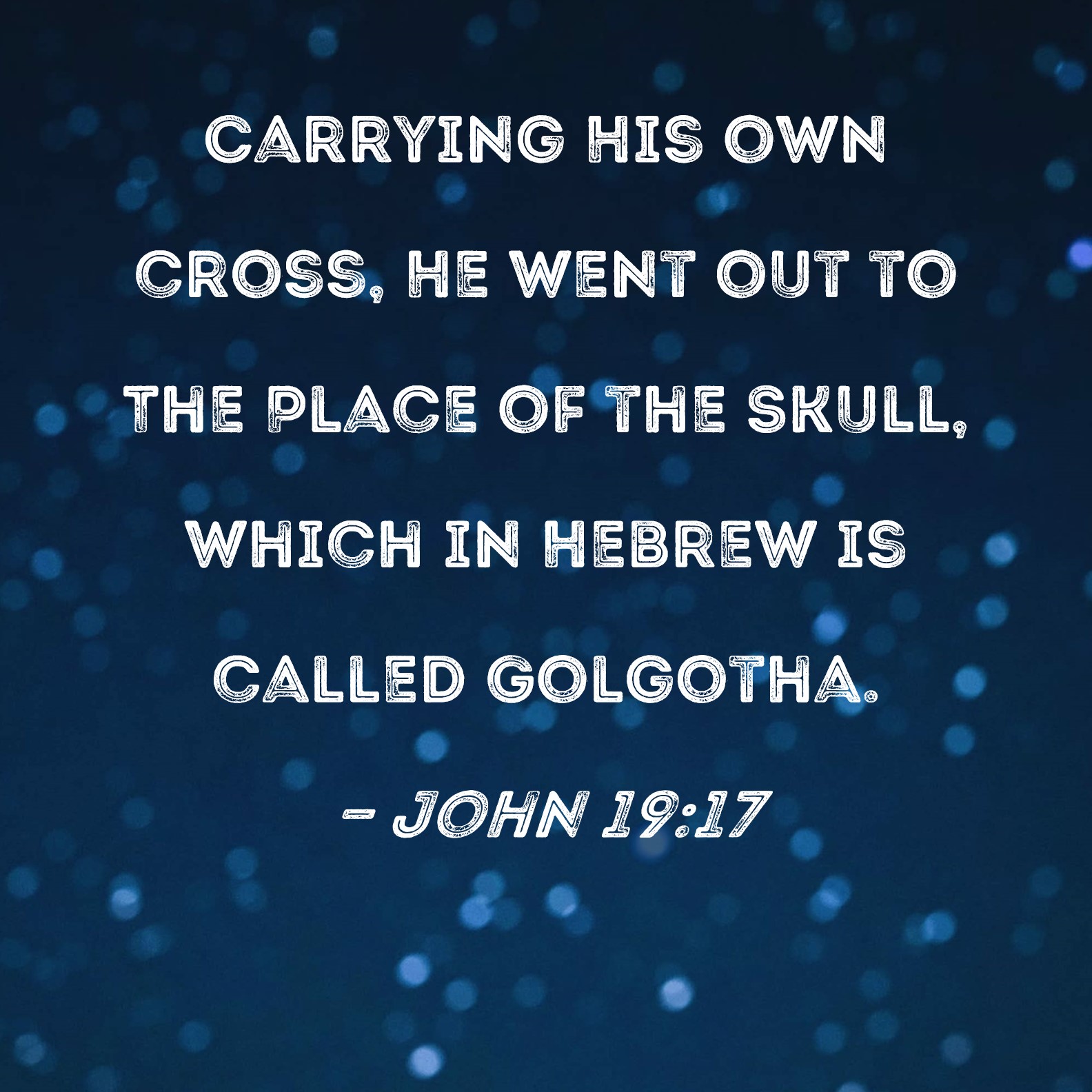




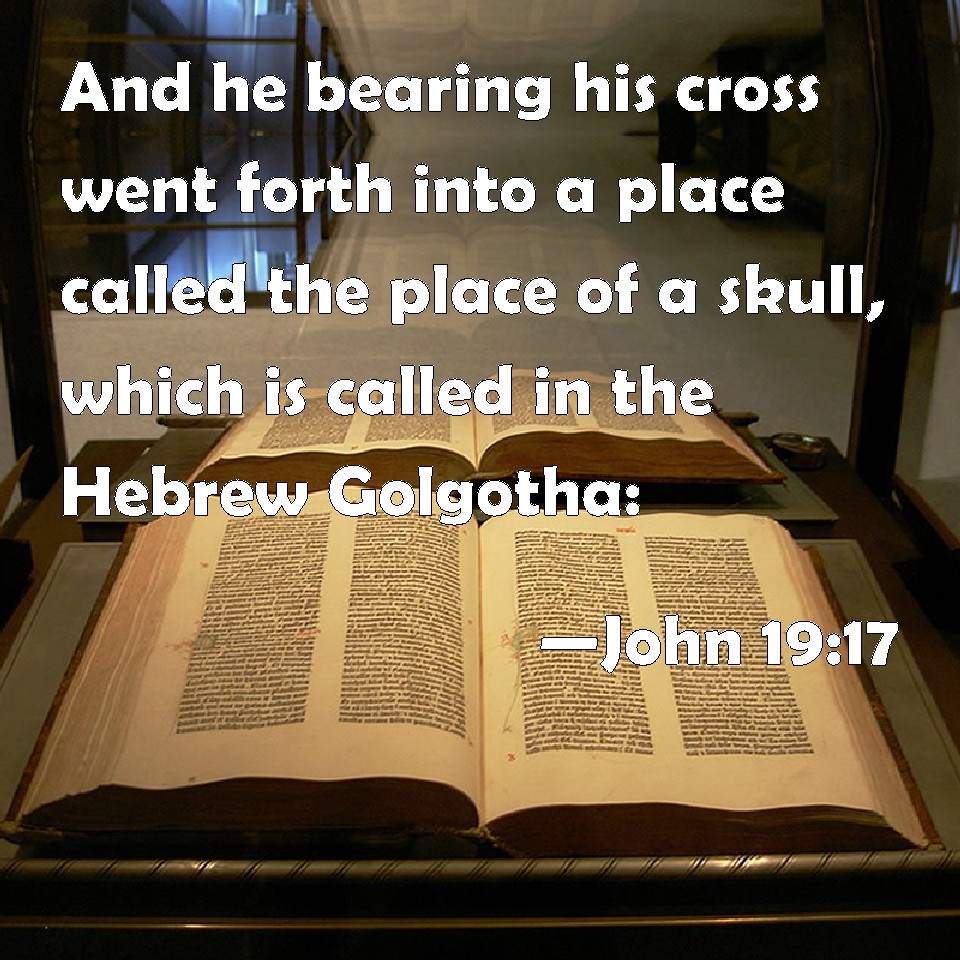
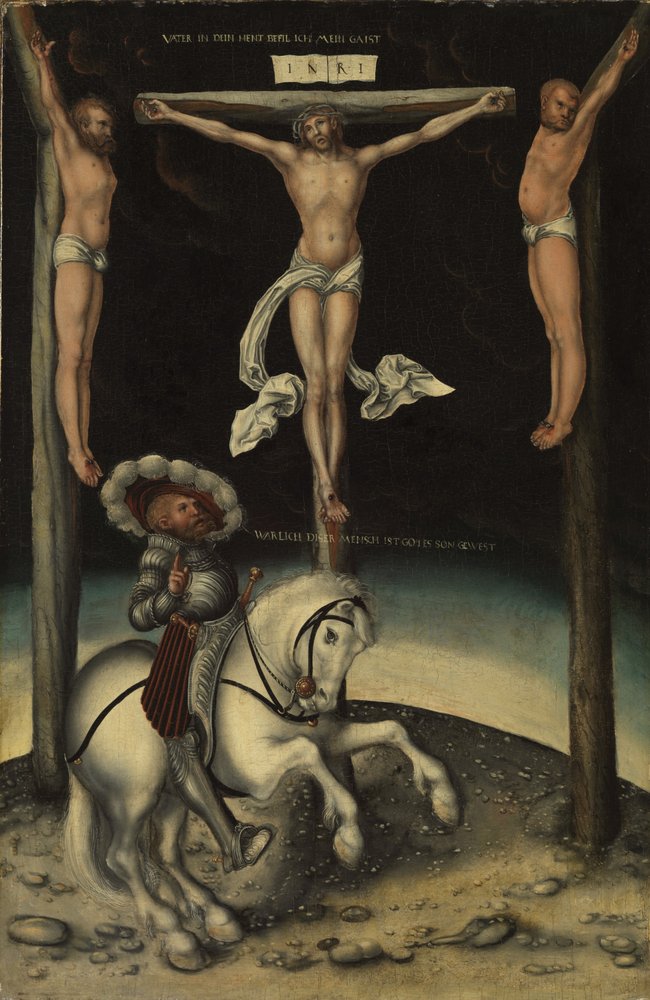
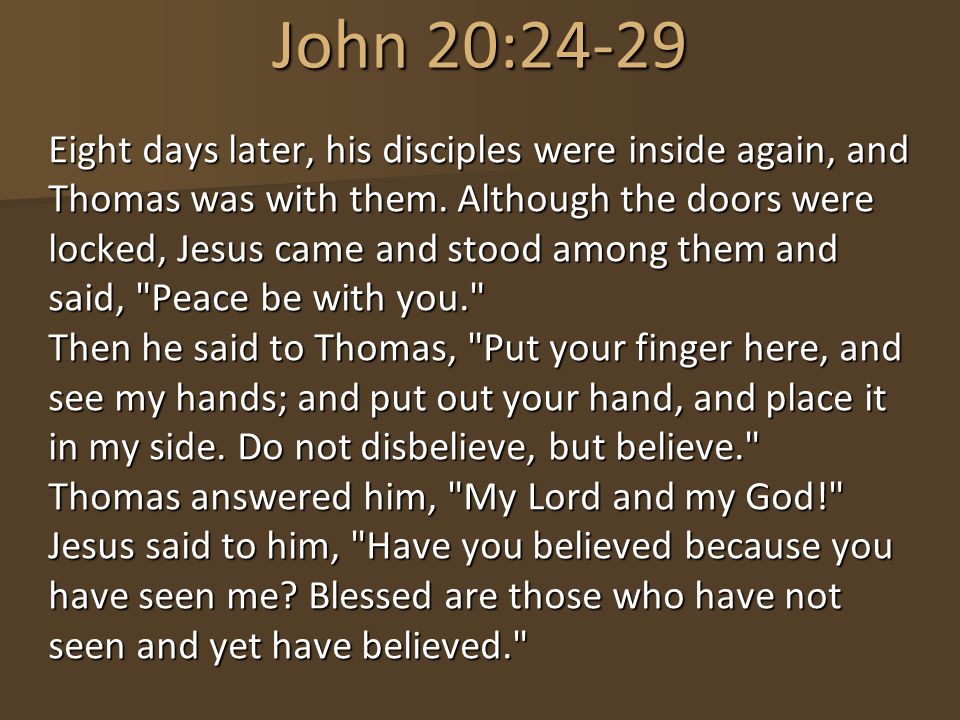
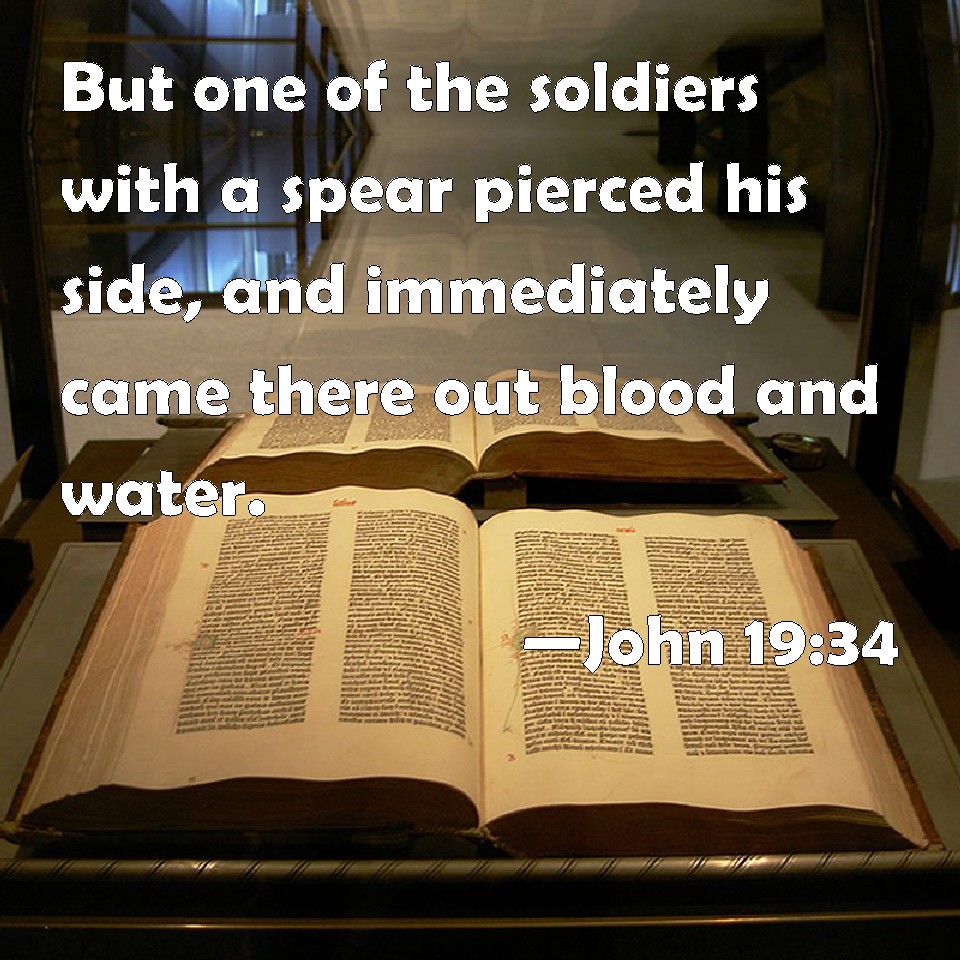



![Regreso Al Fururo III (Back To The Future III) [1990] –, 40% OFF](https://m.media-amazon.com/images/M/MV5BYzgzMDc2YjQtOWM1OS00ZjhhLWJiNjQtMzE3ZTY4MTZiY2ViXkEyXkFqcGdeQXVyNDQ0MTYzMDA@._V1_.jpg)
















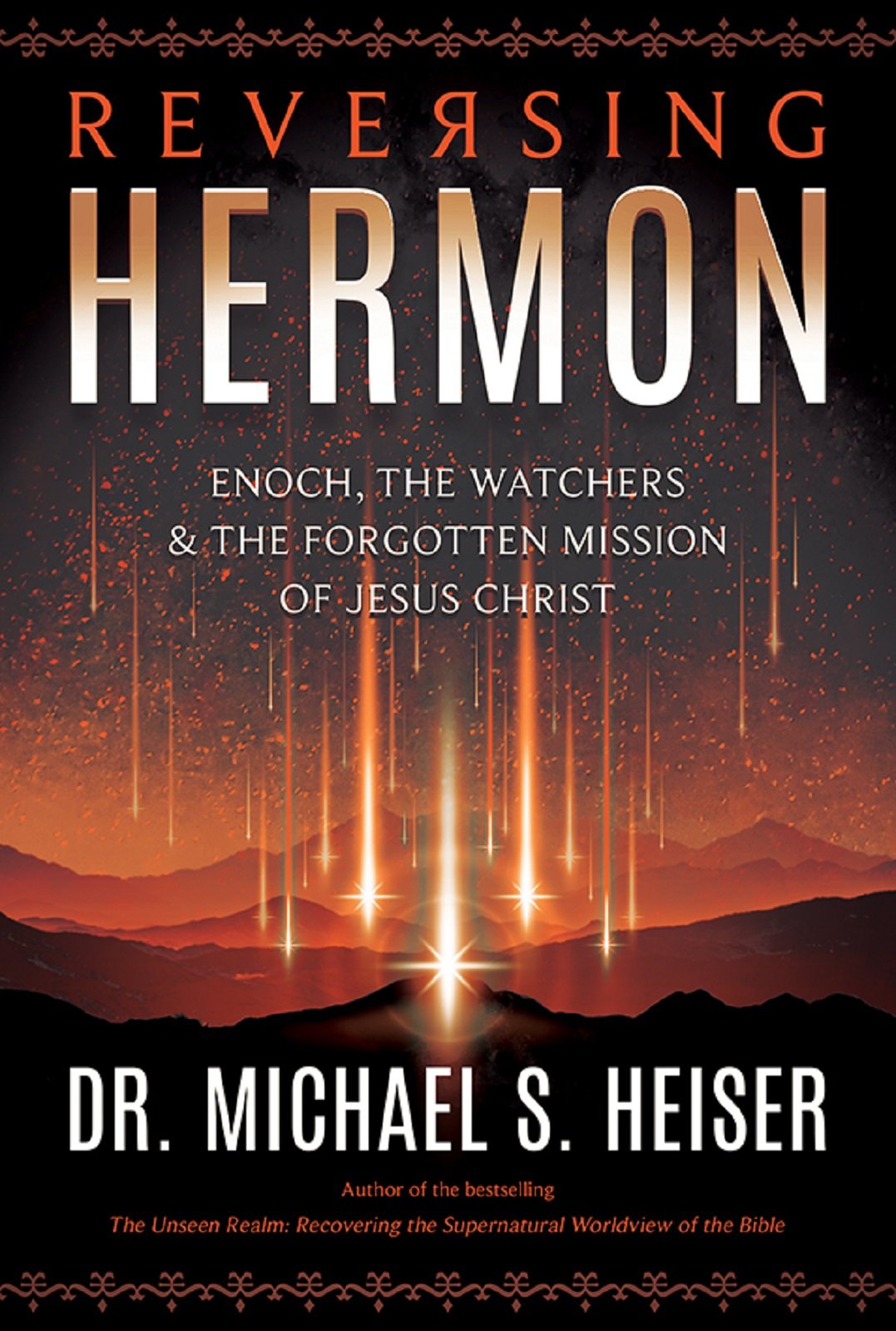
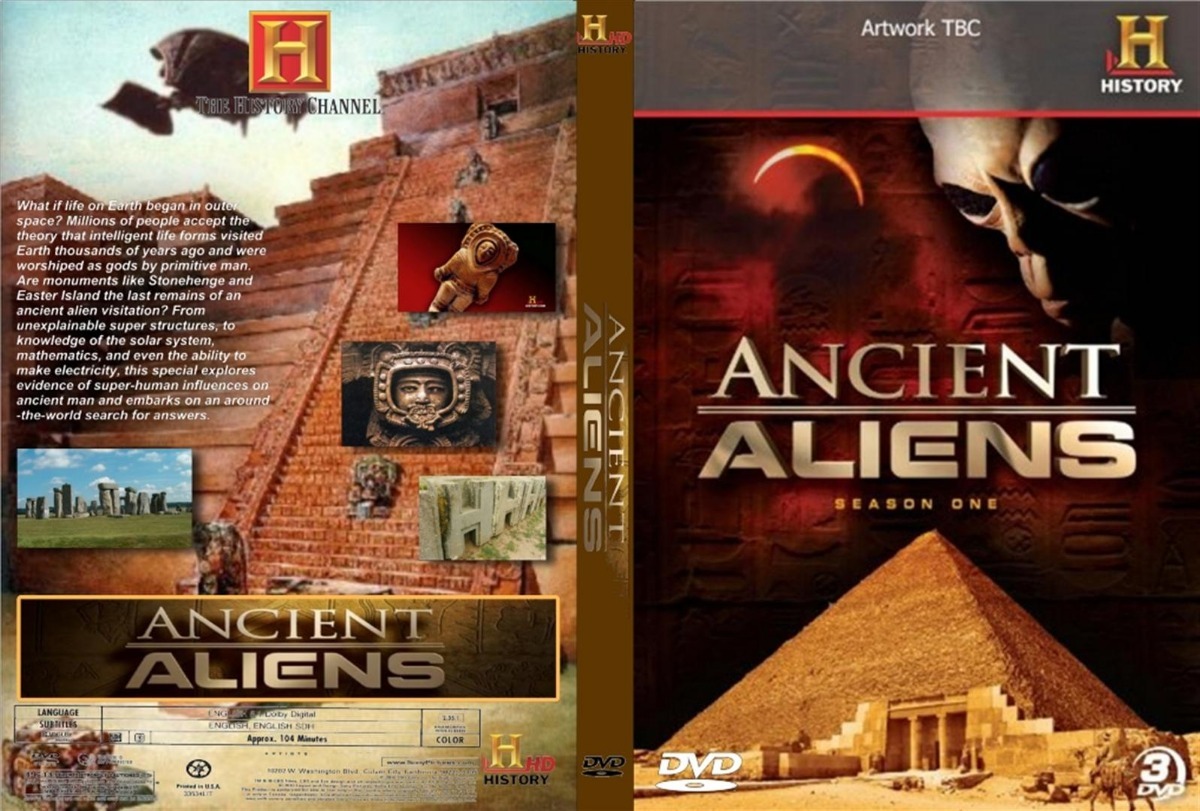

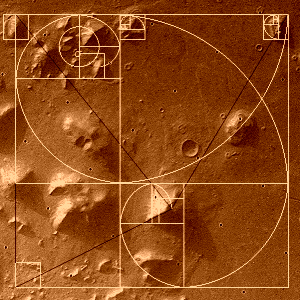
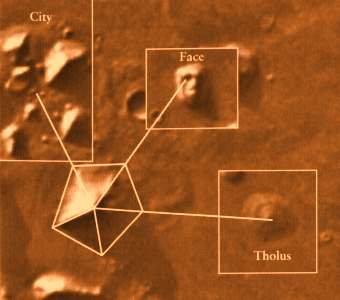

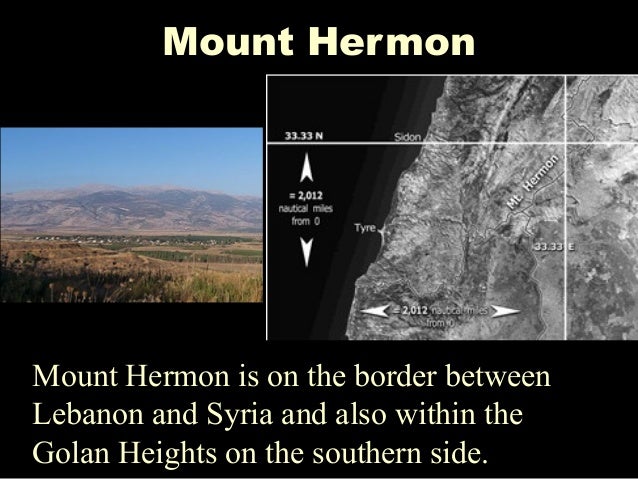

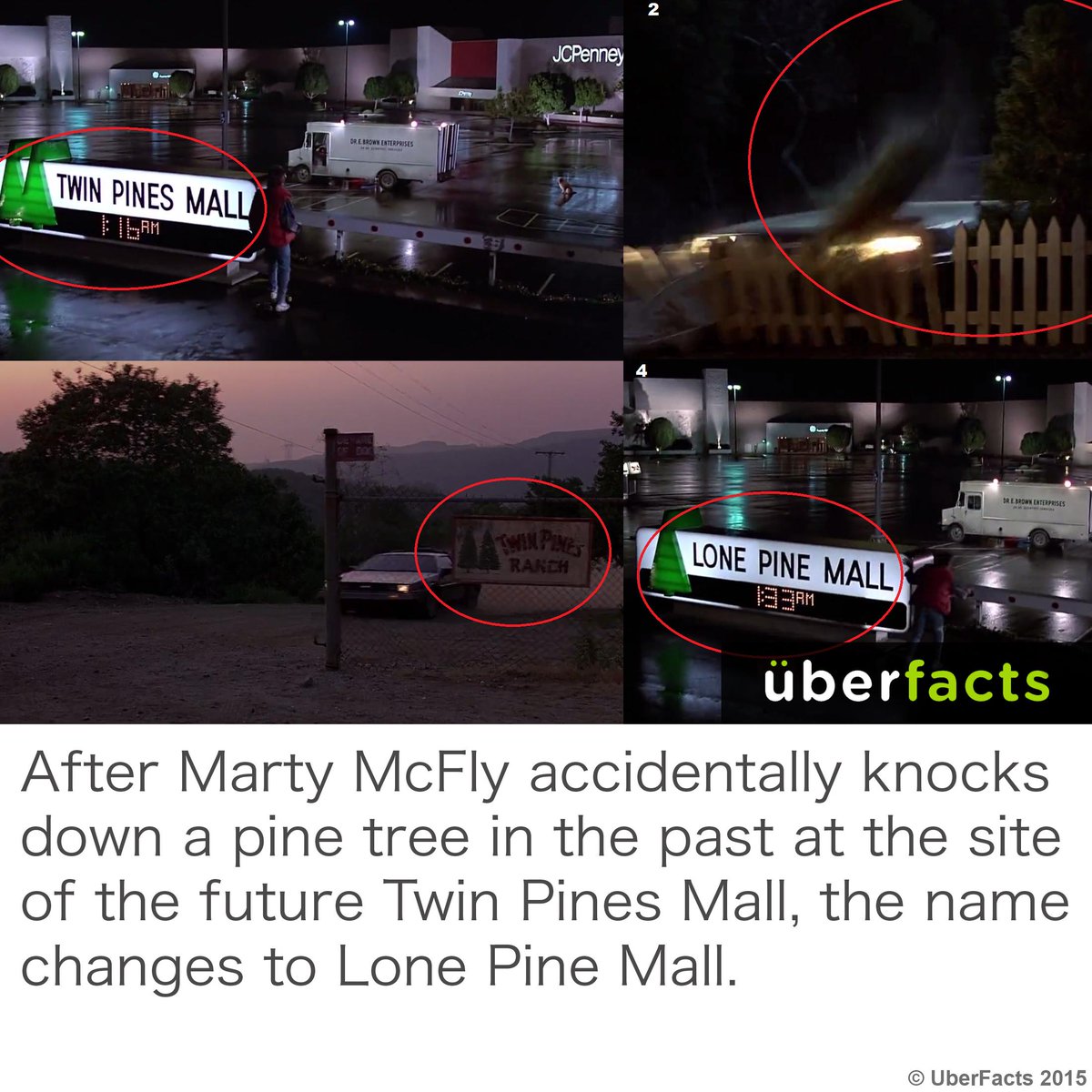




![Revelation 1:14 (lsv) - and His head and hairs [were] white, as if ...](https://img2.bibliaya.com/Bibleya/verse/revelation-1-14-lsv.jpg)



















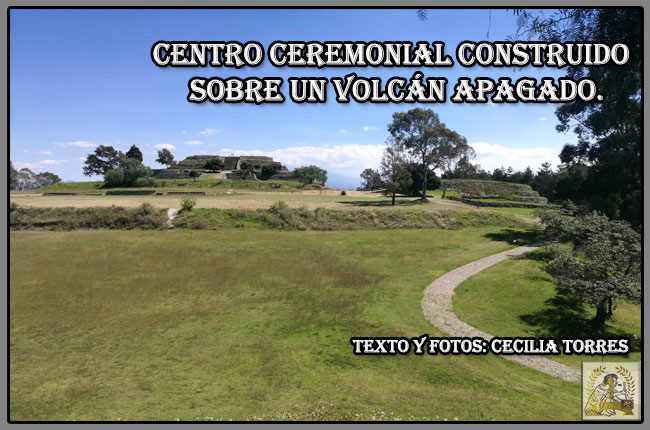















 Napoleon had acquired two nicknames, one being 'L'Aigle' (the Eagle) and the other being 'L'Etoile' (the Star). That 'his star' was Sirius, the star of Isis, is not only made obvious by the coat-of-arms which he chose for Paris but, in a more arcane manner, it seems to have been linked to Napoleon's most famous monument, the Arc de Triomphe, also known as the the Place de L'Etoile (the Place of the Star),
Napoleon had acquired two nicknames, one being 'L'Aigle' (the Eagle) and the other being 'L'Etoile' (the Star). That 'his star' was Sirius, the star of Isis, is not only made obvious by the coat-of-arms which he chose for Paris but, in a more arcane manner, it seems to have been linked to Napoleon's most famous monument, the Arc de Triomphe, also known as the the Place de L'Etoile (the Place of the Star),  located on the western side of the so-called Historical Axis of Paris, better known as the Champs-Elysees, [which is oriented twenty-six degrees north of west]... The star Sirius, as seen from the latitude of Paris, rises twenty-six degrees south of east.
located on the western side of the so-called Historical Axis of Paris, better known as the Champs-Elysees, [which is oriented twenty-six degrees north of west]... The star Sirius, as seen from the latitude of Paris, rises twenty-six degrees south of east.
 Relic of Mary Magdalene, Vezelay basilica
Relic of Mary Magdalene, Vezelay basilica Saint Bernard preaching the 2nd Crusade, in Vézelay, in 1146, Émile Signol – Public domain
Saint Bernard preaching the 2nd Crusade, in Vézelay, in 1146, Émile Signol – Public domain Vezelay basilica
Vezelay basilica St Maximin basilica
St Maximin basilica
